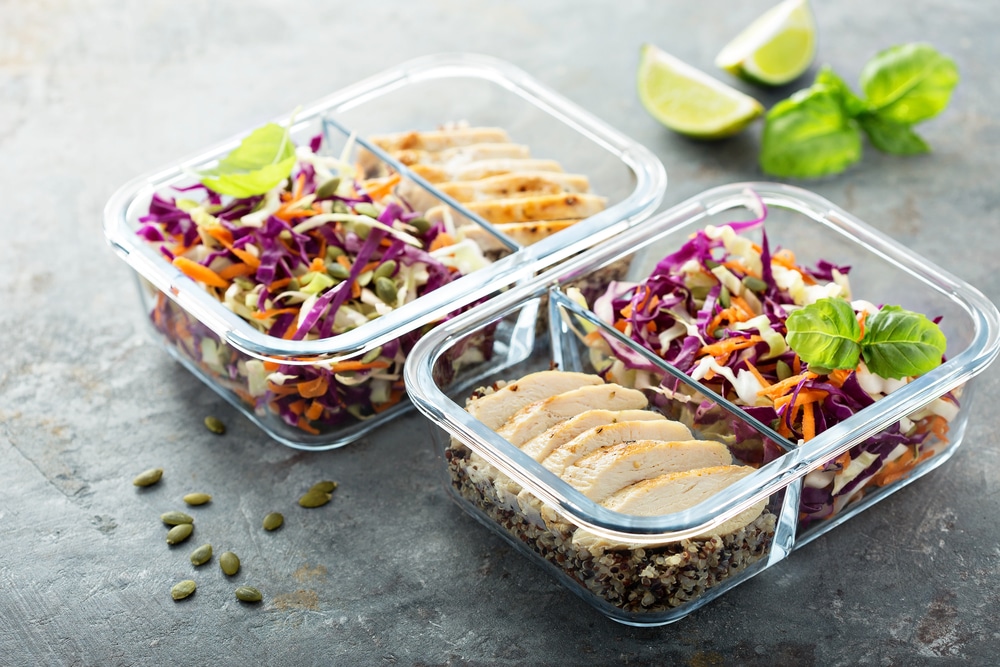
10 Portion Control Tips
We aren’t going to sugar-coat it: America has a serious problem with portion control.
Americans currently eat approximately 20 to 25 percent more calories than in 1970, with the average person eating more than 2,670 calories per day.
In the land of supersizing and foot-long sandwiches, our high BMIs, sedentary lifestyles and declining health are clear symptoms of people who do not know how to consume the correct portions. Research has shown that large portions of food push people to eat more, so the cycle can be difficult to stop without education and willpower. Hopefully, this blog post will provide you with both of those things.
Aside from consuming fewer calories, portion control is also necessary to ensure our bodies get the proper amount of vitamins, minerals and fiber that they need to function correctly.
Here are 10 essential portion control tips that everyone should know:
1. Follow the 50/25/25 rule
For breakfast, lunch and dinner, half of your plate should contain vegetables, one quarter should contain lean protein and the other quarter should contain starchy vegetables or carbohydrates. (Make sure you also consume some dairy and a couple of cups of fresh fruit each day.) A large portion of vegetables, while low in calories and fat, will satisfy the psychological need to fill up the plate with food, ultimately reducing one’s need to consume more carbs or fatty foods.
2. Your dinnerware is too big
In the 1960s, the average plates sold in the U.S. were around 9 inches in diameter. In the 1980s, the plates grew to around 10 inches in diameter and presently, plates are averaging 12 inches in diameter – a stunning 33 percent increase in size from the 1960s. These increasing plate and bowl sizes lead us to shovel more food on our plates and then ultimately into our mouths. Purchase 9-inch plates and small bowls to control portion sizes and prevent overeating.
3. Choose healthy over processed
Fresh, natural and healthy foods will fill you up faster and will make you feel full longer than processed foods. This will help control portion sizes, as well. An excellent example is choosing to eat whole grains, because they will provide your body with more nutrients and will also fill you up faster than refined grains (e.g., white bread).
4. Cut up the food first
Sometimes visuals can be deceiving. Before plating the meal and sitting down to eat, cut up the protein and other foods. The smaller pieces will take up more space on the plate, tricking your mind (or your family’s minds) into thinking there is more food, while simultaneously reducing portions.
5. Don’t eat straight from packages
When we eat something straight from its bag or box, we usually end up eating more than we are supposed to. Curb this temptation by putting a healthy amount of the food in a bowl or on a plate, then put the container back into the fridge or pantry. You can also try buying single-serving snacks to prevent overeating.
6. Split restaurant meals into two
It’s no secret that portion sizes at restaurants keep getting larger and larger every year. When eating out, opt to either split the dish with a friend or family member, or ask for a to-go container immediately, so you can put half of the meal inside it. This will prevent the desire to eat everything on the plate, while also saving money.
7. Make single-serving leftovers
Leftovers help us save money and time, and they can also be used for portion control. After you’ve cooked a meal, separate leftovers into single servings to prevent eating an unhealthy portion next time.
8. Feel free to snack
Do you often find that you or a loved one get hungry in between meals? Make sure your home has healthy snacks, such as apples and almond butter, vegetables and hummus, a boiled egg, yogurt, whole grain chips or your favorite nuts. Snacking when hungry (yes, even before dinner!) will prevent extreme hunger during the next meal, so that you don’t overeat.
9. Set aside condiments and sauces first
Americans often tend to overdo it when it comes to syrups, sauces and condiments. Instead of pouring a condiment on top of your food, it’s best to reverse the order. First, premeasure the amounts of each condiment that the meal will need, and then cook your meal. This will prevent the desire to drown your food in fatty condiments.
10. Don’t eat when you’re distracted
Studies have shown that people aren’t mindful of how much they eat when they’re distracted. (Distracted can mean watching TV, working on a laptop, talking on a phone, driving, etc.) So the answer is simple: don’t eat while distracted. If you must eat while watching TV or engaging in another distraction, make sure you sit down with the appropriate portions.
Keep in mind that people of different ages may have different nutritional needs. This information on the USDA website will provide additional help to ensure you and your loved ones are getting the right vitamins and minerals. There is also a helpful USDA MyPlate Checklist Calculator that, based on the person’s age, weight and other information, reveals the ideal quantity of certain foods that should be consumed each day.
Teaching yourself (and your family) about proper portion sizes is crucial to maintain a healthy weight and body. Want to learn more about proper nutrition, healthy food tips and robust recipes? Check out Scripps Affiliated Medical Groups’ articles for more great information!

Join our Senior Wellness Society for the latest news on Medicare and tips for healthy living in San Diego!
Sign up now ›Are you looking for specialized medical care in San Diego?
Our directory has more than 850 doctors in San Diego County of various specialties who are available to help you.
Find a doctor